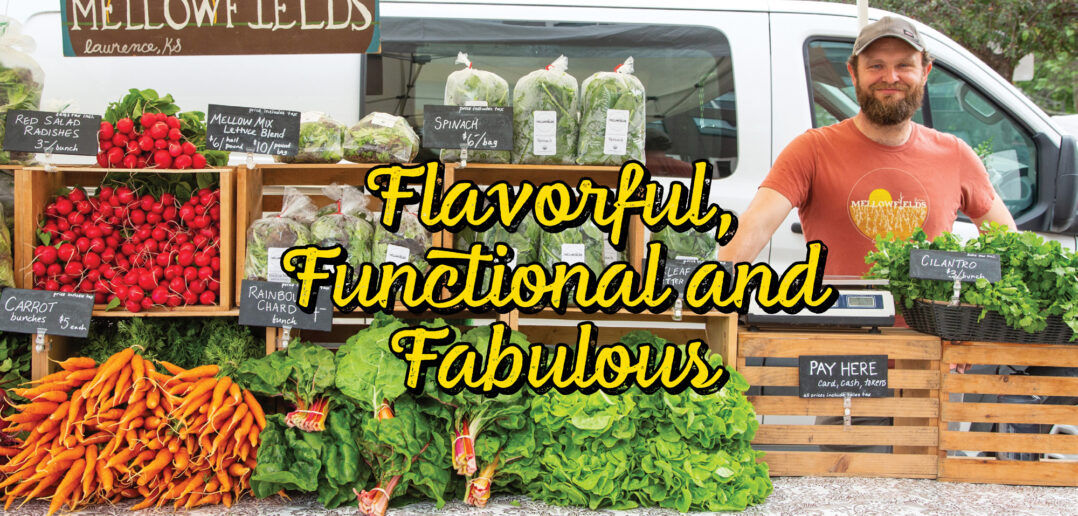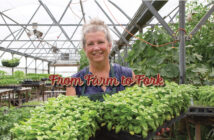| story by | |
| photo by | Steven Hertzog |
| OPEN A PDF OF THE ARTICLE |
The Lawrence Farmers’ Market during the years has become a continually growing, close-knit community of vendors.
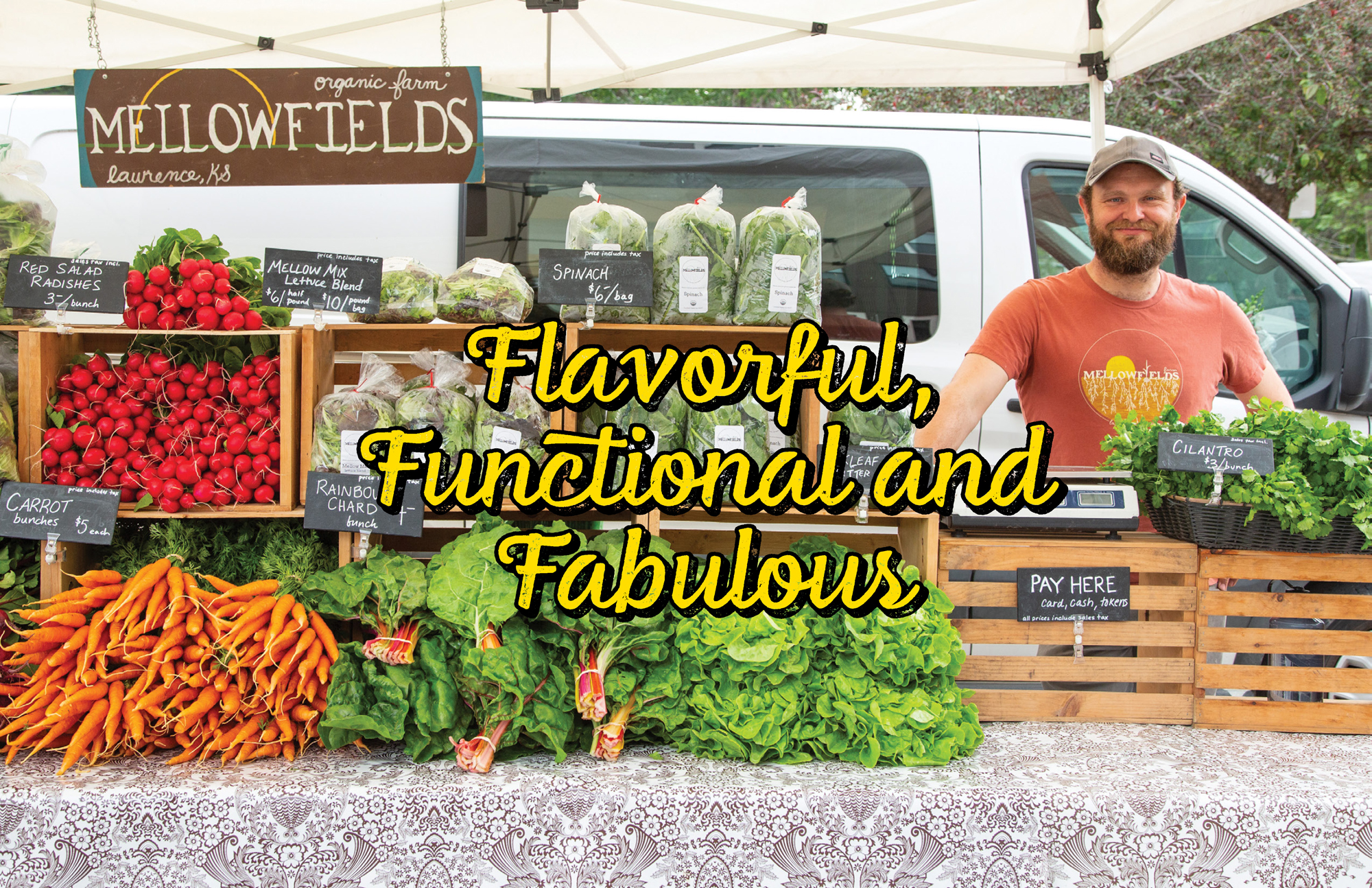
Kevin Prather of Mellowfield’s
Do you make it to the Lawrence Farmers’ Market on Saturday before 9 a.m.? If not, it’s possible you haven’t had a breakfast burrito, tamale or fresh salsa from Circle S Tamales, because they usually sell out before then. Lines start forming at 7 a.m. The many market vendors start the day early to provide their bounty from the earth and trees, or direct from their hands.
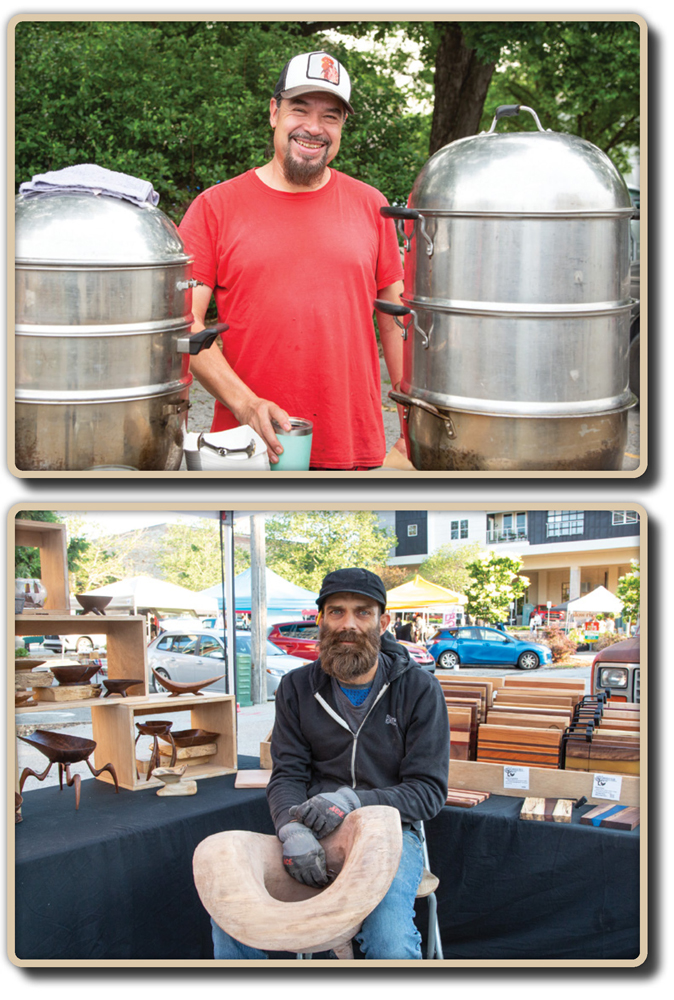
Alejandro Coronado of Circle S Tamales, and Matt Roman of Resurrected Woodworks
Alejandro Coronado, of Circle S Tamales, says waking up and rolling burritos—they take three to four minutes each to roll—at 3 a.m. is a challenge, but one with great rewards. Seeing vendors and market attendees enjoying his products is a gift. “It’s the best stress relief, better than Prozac,” Coronado says. Even the challenges with the weather, as vendors agree is one of the biggest hurdles to overcome with the market, doesn’t dampen spirits. Since Coronado’s kids were young, they have helped him at the market. They are now moving on to college, which shows how long he has been involved. He loves being part of the market, he adds.
While tamales are very important in Latinx cultures, they aren’t as widely known here in Lawrence. Coronado has had to stop a few people from eating the corn husk surrounding the tamale. Nowadays, more people are aware of and really appreciate the tamale, but the breakfast burritos tend to sell more quickly for Circle S.
Coronado is of Mexican descent, but it wasn’t until he moved to Lawrence that he learned how to make tamales. He learned from descendants of Mexicans who settled in Lawrence in 1908 and whose families have been here ever since. Before this time, he would cook many other types of food, including French and Italian. When Coronado is not rolling breakfast burritos, making tamales or cooking Italian or other tasty recipes, he can be found blacksmithing Nepali or Khukuri knives, a unique hobby of his.
Phoenix Rising
Some vendors at the farmers market take a hobby and make it a trade. Such is the case for woodworker Matt Roman, of Resurrected Woodworks. Roman has been a woodworker for 15 years, making cabinets and trim carpentry, as well as furniture, and he couldn’t bear to burn the scraps left over after a project. At one point, he had been going through some dark times and found solace in making art and woodcraft. So he began carving kitchenware and jewelry to create art with the reclaimed cutoffs, creating Resurrected Woodworks in 2017. “It was funny when I realized how the name ‘Resurrected’ was not only referring to the goods I sold but to my life, too,” he admits.
LOCAL MATTERS
Our Local Advertisers – Making a Positive Impact
What started as an additional opportunity to sell his goods other than at art shows has become a continued experience because of the people at the market. “Our community has a deep respect for quality and locally harvested food and crafted goods. I price my goods to be fair to both crafter and consumer, and the Lawrence market respects that,” Roman explains.
He says he enjoys keeping his hands busy sanding while he has great conversations with market patrons. This not only keeps him occupied while tending his booth but seems to be a good draw for others. He enjoys interacting with both the attendees and the other market vendors, and is grateful for the support from not only his clients but also other vendors. He has found the relationships that have developed into the biggest rewards from his involvement in the Lawrence Farmers’ Market.
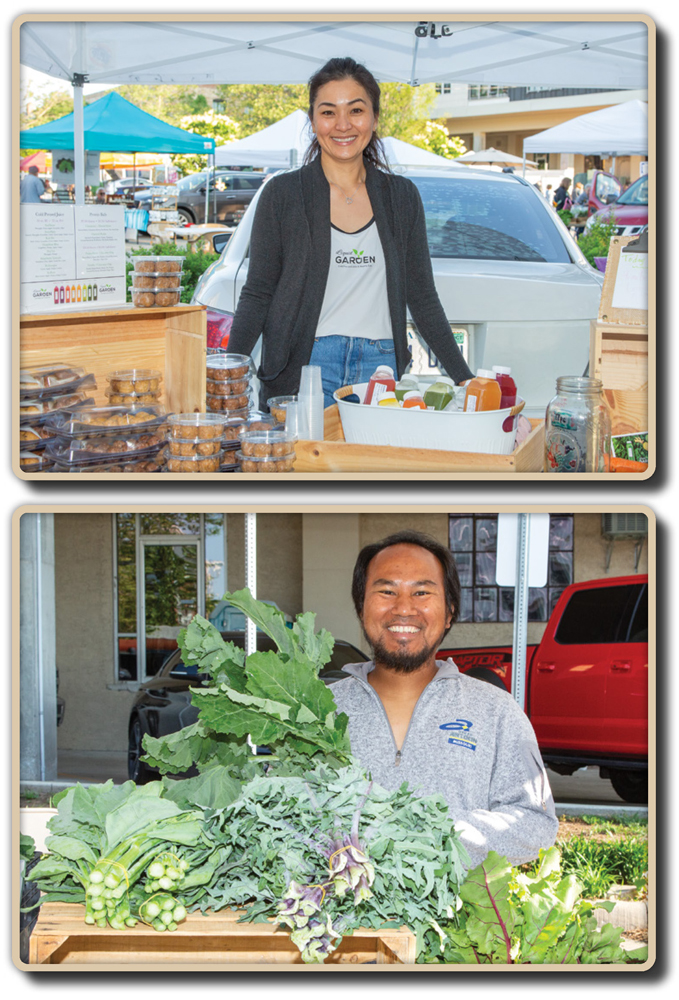
Thuy Soldner of Liquid Garden Juice Co. & Ca Saw of Green Fresh
Juice for the Soul
Thuy Soldner, of Liquid Garden Juice Co., has found a huge benefit from the relationships with her neighbor vendors, farmers and the community, and as a second-year vendor, she’s grateful for their feedback on her cold press juices and healthy eats, such as protein balls. The juice is made using no heat and only fresh, organic, raw vegetables and fruits that are ground up and pressed into the bottle. They have no added ingredients like sugar or preservatives. Soldner describes her style of juice and food as “Clean eating. Health and wellness. Fruits to roots.”
An example of one of her cold press juices is Grapefruit Bliss, which includes grapefruit, apple, orange and ginger. It has a pleasant aroma of grapefruit followed by the nice, pungent spice of ginger and smooth apple, with an additional hint of citrus from the orange. It is smooth and refreshing. Another example is Strawberry Limeade, with ingredients including strawberry, red and green apples, lime, candy beet and pears—it’s sweet even without additional sweeteners. There is a very subtle, exotic, slightly earthy aroma from the beets below the familiar smell of strawberries and lime. The two different types of apples, pears, strawberries and candy beets create a unique nectar taste, while the lime provides a citrus tang to balance the sweetness.
Soldner and her husband, Jay, are high school sweethearts who came to study at The University of Kansas and stayed. He is a photographer, and she ran a clothing store until she started helping out as the marketing director for a friend’s cold press juice business, Lucky Berry, in downtown Lawrence. When the business shut down, Soldner was passionate about Lawrence needing these fresh, healthy drinks and eats. The couple opened a kitchen in January 2022 for making the juices and protein balls, and they offer pickup as well as delivery. Soldner equates the delivery to the vintage milk bottle delivery but with fresh, natural cold press juices.
She is grateful for the farmers market team and its vision for the future. She loves the social aspect and seeing who comes out to the market, their pets, their families. “The vibe is amazing. It’s a lot of goodness,” she says. The sellers are very supportive of each other, and it is a way of living for most of them. Soldner also enjoys that her 10-year-old came to the majority of the markets with her last year, and she loves promoting healthy living using fresh pressed juices.
A Fresh Start
Another vendor, Green Fresh, grows many types of edible veggies, including a few varieties of lettuce and three varieties of kale, sweet chard, snow peas, mustard greens, bok choy, green onions, garlic, tomatoes and beans. Ca Saw is the owner of the small farm which grows everything on a half-acre of land. Cut flowers make up around half of the farmers market sales.
Saw is originally from the Chin State in the country of Burma, which has limited roads and access. The state’s religion is a majority in its area but a minority in the country. He left Burma with a friend because of religious persecution and initially moved to Malaysia. From Malaysia, his friend moved to Chicago, while he headed to Kansas City in 2017, where four of his cousins lived. In 2019, Saw got involved with a refuge program called New Roots for Refugees. This three-year program provides knowledge on how to grow produce. After graduating from the New Roots program, he started Green Fresh. The company has been in business for around a year now. He is married and has two children.
Being part of the farmers market has been very helpful, allowing him to build a clientele and sell direct to buyers. Because the farm is small, he doesn’t have enough land to sell wholesale at this time, but he has enjoyed interacting with the market attendees and learning more English.
Saw has noticed that some of the older generations at the market are reminiscent about the vegetables that Green Fresh provides, which reminds them of recipes and good times when they were younger, he explains. Many from this generation know good recipes and ways of cooking different vegetables. Those from younger generations ask questions about how to cook the fresh food he provides—for example the best way to prepare kale—and he appreciates how friendly most people are who visit the market.
When he is not working or with his family, you may find Saw playing soccer, which he loves. Last year, he coached soccer, but with his busy schedule, he had to give it up for the time being. He says he hopes to expand his growing acreage and continue to provide fresh greens and cut flowers for his clients at the farmers market.
Growth in the Community
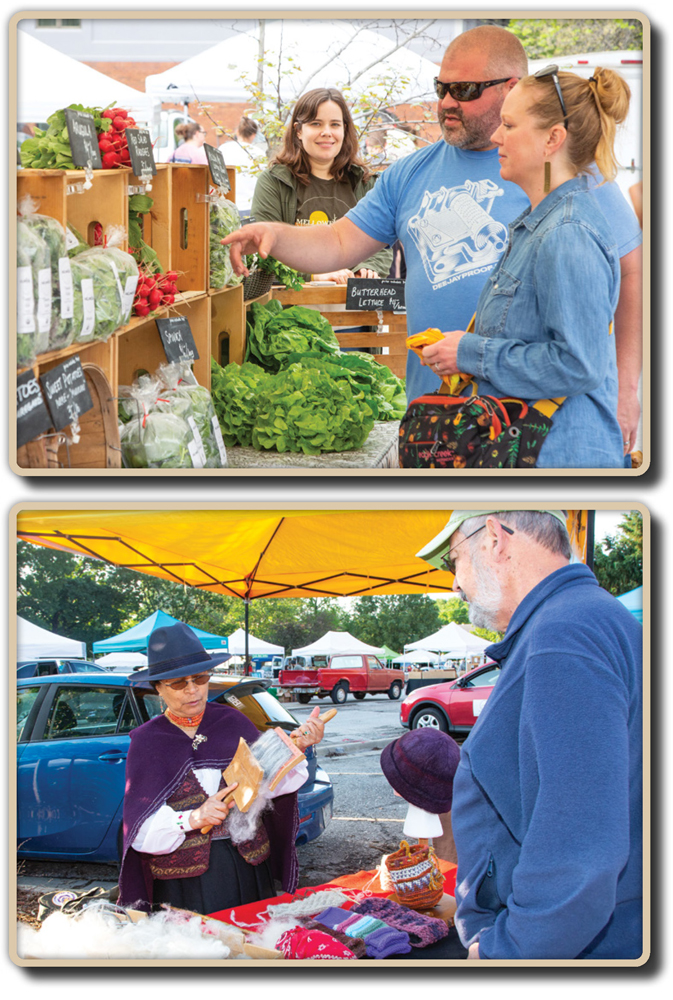
Top: Customers looking over the produce at Mellowfield’s , Nina Kinti-Moss of First Weavers shows her technique to out of towner David Claypool
Mellowfields Farm is another farm that provides greens and things to the Lawrence Farmers’ Market. It has been in business since 2008, starting out as a CSA (Community Supported Agriculture), and has worked with the farmers market since 2011. A CSA is an agreement where the buyer pays up front for a whole season of produce. The owners started at the farmers market because they had more produce than expected and then realized this was an opportunity to become a consistent and reliable vendor. This is the first year Mellowfields hasn’t been involved with a CSA.
Mellowfields owners Kevin Prather and Jessie Asmussen have 4.5 acres of land and are farming 3.5 of that. The farm is located on the eastern edge of Lawrence, in the Kaw River Valley. It provides many types of vegetables including what they call “Mellowmix,” a variety of eight types of lettuce. Also grown are tomatoes, cucumbers, peppers, potatoes, carrots and beets.
The Lawrence Farmers’ Market has been a great experience for Mellowfields Farm. Even though he is somewhat of an introvert, Prather says he has really enjoyed getting to know people from the community.
Some people attend the market for groceries, others for hot food. Some are college students who may want to eat healthily but do not know how to cook; others are stay-at-home parents who like to cook good food. There are many different reasons they come to the market, Prather explains. “People come for the experience, the activities for kids, music and more. It’s a positive experience.” It’s a great place to be in front of the community and get their brand out there, he adds.
Prather has been on the Lawrence Farmers’ Market board of directors, and one of its committees is currently looking for a permanent location for the market. A location with pavilion space would be excellent for the market, providing solutions to challenges such as the lack of electricity, permanent cover and restrooms.
Prather says he’s happy with the direction of the market and the way it has grown. He says Emily Lysen, who is the director of development, has done a great job.
Busy Hands
Nina Kinti-Moss, of First Weavers, has been selling her hand-spun, hand-dyed natural alpaca wool fiber, cotton, silk and other material handmade goods at the Lawrence Farmers’ Market since just before the turn of the century. Before that, she was going to art shows with her tapestries and would show her goods at various locations whenever a spot would open up. All her products are hand-dyed using walnut dye or aniline dyes, such as lemon and vinegar, or other natural dyes. She also produces beadwork jewelry, feather earrings and other jewelry. In cooler weather, she offers mittens, hats and pouches. In warmer weather, she offers fresh lemonade, juices and coffee.
Originally from Salasaca, a small dessert community of 12,000 people in Ecuador, she learned the traditional style of weaving using an Indian-style drop spindle. With this style of weaving, you wear a belt and carry the spindle, allowing the weaver to be mobile. Kinti-Moss says she enjoys demonstrating how to weave the products she produces. She came to the United States as a student in Wisconsin before moving to Lawrence in 1995.
Kinti-Moss enjoys working with her hands. She tries to educate those who don’t know about the traditional weaving. “It takes a lot of time. It requires lots of work, patience, washing, spinning,” she explains. “I can’t stop. Machine-made isn’t comparable to hand-made things … It is priceless.” She keeps track of the time it takes to make the products so she can help people understand their value.
Many people drive long distances to buy her products and also send her products overseas to other countries. The farmers market gives her a venue to sell her wares, share with the attendees and cover additional costs. She says she appreciates the market has “people and vendors [who are]conscientious, organic, careful of what they sell. As well as reasonable pricing.”
Stalk of the Town
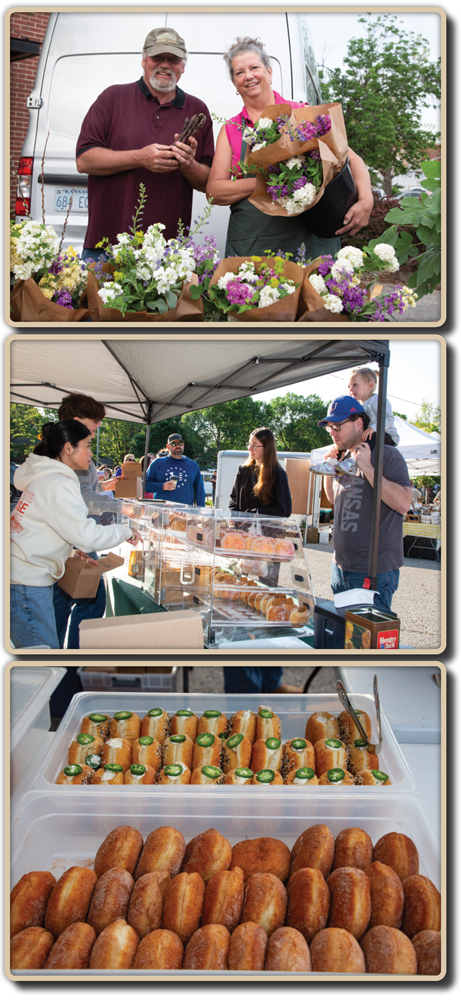
Top: John and Karen Pendleton of Pendleton Country flMarket showing off their asparagus and fresh cut flowers, Jessica Dunkel busy selling her Slow Rise donuts to her waiting cus-tomers
A name that is well-known to the Lawrence Farmers’ Market is Pendelton’s Country Market. It should be well-known: John and Karen Pendleton have been selling at the market for 40 years. In 1980, there was an agriculture crisis that caused their farm, and many others, to switch to growing specialized produce to weather storms both physical and man-made. The couple’s focus was on growing asparagus. They made a practical decision which turned out to be a great marketing decision by creating a waiting list. When a client’s name came up, he or she was limited to only 10 pounds of asparagus. They sold 10 pounds to every client.
Keeping up with trends can be a challenge. Thankfully, asparagus has done well for them. Karen Pendleton says, “Kale was hot, and now it’s not.” Their offerings at market are based on what is in season, so for May, it is asparagus. June is for peas, potatoes and more greens. July is sweet corn and berries. Tomatoes are in July or August. Many people don’t realize that cut flowers are just as important for Pendleton’s as the greens. They pick peonies in bud. The peonies open right before market, which helps them last longer.
The Pendletons used to sell wholesale to restaurants such as Arthur Porters, Tin Pan Alley and Cornucopia. But they are not selling as much wholesale now. They do have a CSA, but a large portion of their business is direct to retail at the farm and the farmers market.
Both John and Karen Pendleton are social and enjoy being part of the market and meeting people who support local farms there. They get a lot of questions about growing, cooking and farm living. In addition to traditionally grown tomatoes, the Pendletons grow them hydroponically, which allows them to be available earlier in the season. Karen Pendleton says they field a lot of questions about hydroponic growing, and she spends a lot of time educating about the weather. The couple decided to start a podcast to answer all those questions and more called “The Stalk of the Town, Our Farm and Community.”
Sweet and Sour
While it is always a good idea to get to the market early, if you have a bit of a sweet tooth, you may want to get there a little earlier to beat the rush created by Slow Rise Donuts. When food scientist and self-taught baker Jessica Dunkel was gifted a sourdough starter from a friend, the first thing she made was a donut, something she had been making off and on for some time. It took some recipe adjustments, but she was able to come up with a unique take on a traditional donut with a filled sourdough donut. “The name [Slow Rise] came from the process of making these sourdough doughnuts; the dough is slowly risen because we use 100% wild yeast (versus commercial yeast), and it takes 72 hours from start to finish,” Dunkel explains.
Slow Rise Donuts as a business has been in operation for a year, and Dunkel and her family thought the Lawrence Farmers’ Market would be a great place to test the market as a startup. Being part of the market has allowed for “some of the freshest local and seasonal fruit and produce that we can use as ingredients in our doughnuts fillings,” she explains.
Dunkel was born and grew up in Indonesia, and in addition to using fresh, local ingredients, she also introduces flavors from her heritage in the donuts. “It’s been really fun to experiment and come up with unique flavors, and I’m so glad that our customers are so open to try them,” she says. Her family loves being able to build direct relationships with customers and other market vendors.
The Lawrence Farmers’ Market has more than 60 to 70 different vendors that provide farm-fresh vegetables, greens, meats, fruits, handmade goods, hot meals, drinks and all sorts of bounty from the earth. It is a wonderful Saturday morning experience with something for everyone, including children, to enjoy. It’s a place to walk your pets, learn where your food comes from, see how things are made and meet some great people from the community. Perhaps the next time you go to the farmers market, you might look at the vendors a little bit differently and maybe even consider getting there early to make sure you don’t miss that special treat.

